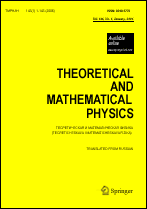|
This article is cited in 5 scientific papers (total in 5 papers)
Integration of a deep fluid equation with a free surface
V. E. Zakharovabc
a Shirshov Institute of Oceanology of the Russian Academy of Sciences, Moscow, Russia
b Skolkovo Institute of Science and Technology,
Skolkovo,
Moscow Oblast, Russia
c University of Arizona, Tucson, Arizona, USA
Abstract:
We show that the Euler equations describing the unsteady potential flow of a two-dimensional deep fluid with a free surface in the absence of gravity and surface tension can be integrated exactly under a special choice of boundary conditions at infinity. We assume that the fluid surface at infinity is unperturbed, while the velocity increase is proportional to distance and inversely proportional to time. This means that the fluid is compressed according to a self-similar law. We consider perturbations of a self-similarly compressible fluid and show that their evolution can be accurately described analytically after a conformal map of the fluid surface to the lower half-plane and the introduction of two arbitrary functions analytic in this half-plane. If one of these functions is equal to zero, then the solution can be written explicitly. In the general case, the solution appears to be a rapidly converging series whose terms can be calculated using recurrence relations.
Keywords:
integrability, conformal transformation, drop, bubble, singularity.
Received: 04.09.2019
Revised: 04.09.2019
Citation:
V. E. Zakharov, “Integration of a deep fluid equation with a free surface”, TMF, 202:3 (2020), 327–338; Theoret. and Math. Phys., 202:3 (2020), 285–294
Linking options:
https://www.mathnet.ru/eng/tmf9811https://doi.org/10.4213/tmf9811 https://www.mathnet.ru/eng/tmf/v202/i3/p327
|


| Statistics & downloads: |
| Abstract page: | 526 | | Full-text PDF : | 131 | | References: | 78 | | First page: | 54 |
|




 Contact us:
Contact us: Terms of Use
Terms of Use
 Registration to the website
Registration to the website Logotypes
Logotypes








 Citation in format
Citation in format 
